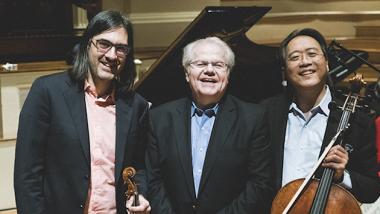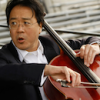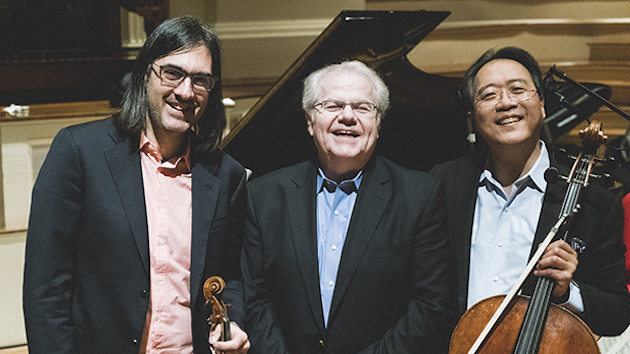
A rock-star vibe pulsed through Berkeley’s Zellerbach Hall on Wednesday night. Three
headliners — pianist Emanuel Ax, violinist Leonidas Kavakos, and cellist Yo-Yo Ma — joined forces for a performance of powerhouse trios by Schubert and Brahms. A big pumped-up crowd included two banks of listeners seated onstage — the chamber music equivalent of backstage passes for those up-close-and-personal members of the audience.
Fans applauded between movements, as if each Allegro and Scherzo were a hit song. The musicians countered the continuity-breaking shows of approval by performing, after intermission, the last three movements of the Brahms Piano Trio No. 1 without pause.
Then and throughout, there was nothing stern or sober about their affect. Ax, Kavakos, and the reliably demonstrative Ma grinned at each other and embraced warmly after each piece, like members of a grown-up boy band. As the evening wound toward a close, the three artists engaged in some kidding around before Ax hoisted a microphone to announce the encore: the ravishing second movement of Brahms’s Piano Trio No. 2.
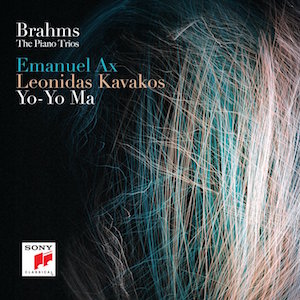
The concert was one of two album-tour dates in the Bay Area. (The barnstorming stars played Stanford’s Bing Concert Hall on Thursday.) A recording of all three Brahms piano trios are out on a Sony Classical disc.
The buzz, once the music began, was just so much noise. This was a night to cherish for its transporting artistry. In passion and subtlety, broad-brush expansiveness, and caressing attention to detail, the performances made these familiar works feel like a new melding of hearts and minds. In their palpable communion with each other, the musicians enfolded their listeners in the kind of intimacy specific to great chamber works performed at this rarefied level.
There was a further distinction to the evening, in the contrasting temperaments of Schubert’s sublime B-flat Major Trio of 1828 and the demonstrative drive of the Brahms B Major Trio, written in the composer’s twenties (1854) and revised and reshaped 35 years later. The Schubert came off in a prevailing mood of serene contemplation and composure, its transparency darkened by storms of foreboding reclaimed by an elegant acquiescence. The Brahms, by turns big-boned and wrenching, brawny and fine-grained, poured forth with a kind of orchestral density and near-reckless sense of abandon. The meditative encore, a searching set of variations that showcased each artist, made a perfectly judged pendant for the evening.
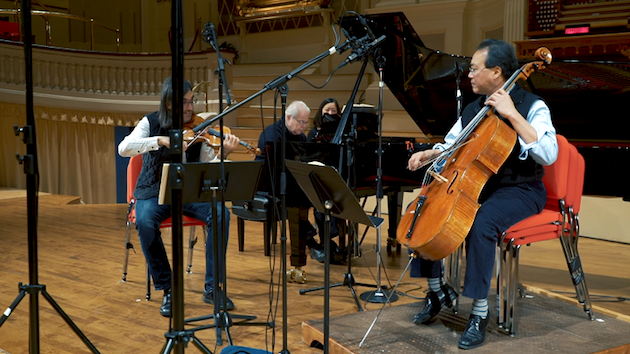
Kavakos and Ma set off an absorbing conversation in the opening bars of the Schubert, the violinist’s lean innocent clarity answered by the cellist’s more somber quizzical tone. Ma, who did things like this all night, gave his phrases a faint upturn and slight rubato at the end, as if to ask of his fellow string player: Is there something more for us to discover together? Ax’s liquid runs and steady pulse were like a stream for the other two to ride. Then, with a sharply sounded accent, the pianist would drive the movement off in some new direction and flow.
With his wonderfully understated delivery of the opening theme, Ma set the terms of the murmurous loveliness of the Andante, offset by the exotic Turkish-sounding strangeness of the middle section. Gently flexed phrases brought the movement to a tenderly becalmed close.
The sense of restraint carried over to the Scherzo, which lacked the requisite angular bite. A thoroughly captivating Rondo swept that one reservation aside. The final movement’s harmonic enterprise came across as a kind of inexhaustible thinking translated into key changes, cunning phrases, and cascading chords. The three performers couldn’t wait to jump up and connect in a well-earned three-way hug.
From its mighty gestural opening to the sweeping argument and infectious rhythms of the final bars, the Brahms made a wide and deep imprint. The whole thing had a kind of sinewy, muscular physicality. Kavakos found a fibrous incisiveness in his bowing. Ma dug out a probing, tragic tone. Ax leaned into volleys of chords.
In the remarkable, almost alarming first movement, the performers all but assailed the melodic motif to wring out every ounce of its potential. The Scherzo’s pattering pulse precharged that movement’s racing eventfulness, giving way to Ax’s watery arpeggios. The Adagio took on a dirge-like solemnity, which was then banished by the heat-filled and exciting charge of the Finale: Allegro.
The burly, gray-haired Ax, gangly Kavakos, and seraphic Ma may not look much like heavy metal dudes. But they rocked out big time at Zellerbach.

